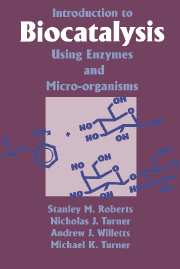Book contents
- Frontmatter
- Contents
- Preface
- Abbreviations
- 1 An historical introduction to biocatalysis using enzymes and micro-organisms
- 2 The interrelationships between enzymes and cells, with particular reference to whole-cell biotransformations using bacteria and fungi
- 3 Useful intermediates and end-products obtained from whole-cell/enzyme-catalysed hydrolysis and esterification reactions
- 4 Useful intermediates and end-products obtained from biocatalysed oxidation and reduction reactions
- 5 Useful intermediates and end-products obtained from biocatalysed carbon–carbon, carbon–oxygen, carbonnitrogen and carbon–chalcogen bond-forming reactions
- 6 The application of biocatalysis to the manufacture of fine chemicals
- Index
4 - Useful intermediates and end-products obtained from biocatalysed oxidation and reduction reactions
Published online by Cambridge University Press: 04 August 2010
- Frontmatter
- Contents
- Preface
- Abbreviations
- 1 An historical introduction to biocatalysis using enzymes and micro-organisms
- 2 The interrelationships between enzymes and cells, with particular reference to whole-cell biotransformations using bacteria and fungi
- 3 Useful intermediates and end-products obtained from whole-cell/enzyme-catalysed hydrolysis and esterification reactions
- 4 Useful intermediates and end-products obtained from biocatalysed oxidation and reduction reactions
- 5 Useful intermediates and end-products obtained from biocatalysed carbon–carbon, carbon–oxygen, carbonnitrogen and carbon–chalcogen bond-forming reactions
- 6 The application of biocatalysis to the manufacture of fine chemicals
- Index
Summary
Introduction
As discussed in Chapter 1, there has been much interest, over many years, in oxidation and reduction reactions catalysed by micro-organisms. Processes for alcohol production and for the manufacture of vinegar and vitamin C have intrigued investigators for ages. Today there is great interest in discovering new whole-cell and isolated-enzyme-catalysed reactions of this type. As described in Chapter 3, the focus of the presentday work in this area is the production of compounds (often in optically active form) that might be useful as intermediates or end-products for the pharmaceutical, fragrance, flavour and agrichemical industries.
For many oxidation and reduction reactions it is often necessary to make a choice between using a whole-cell system or an isolated enzyme (with the requisite co-factors) for the biotransformation. In this area, factors that influence the choice often are much more complicated than those for hydrolysis reactions. The pros and cons of employing whole cells or partially purified oxidoreductase enzymes have been discussed in Chapter 2, and the salient features are summarized in Table 2.3. While the advantages and disadvantages will not be discussed in detail again, many of the points made earlier will recur in this discussion.
Reduction of ketones using whole cells
For example, consider one of the simplest reduction processes, namely the reduction of a ketone to a secondary alcohol. Of course, this can be accomplished chemically using sodium borohydride.
- Type
- Chapter
- Information
- Publisher: Cambridge University PressPrint publication year: 1995
- 2
- Cited by



